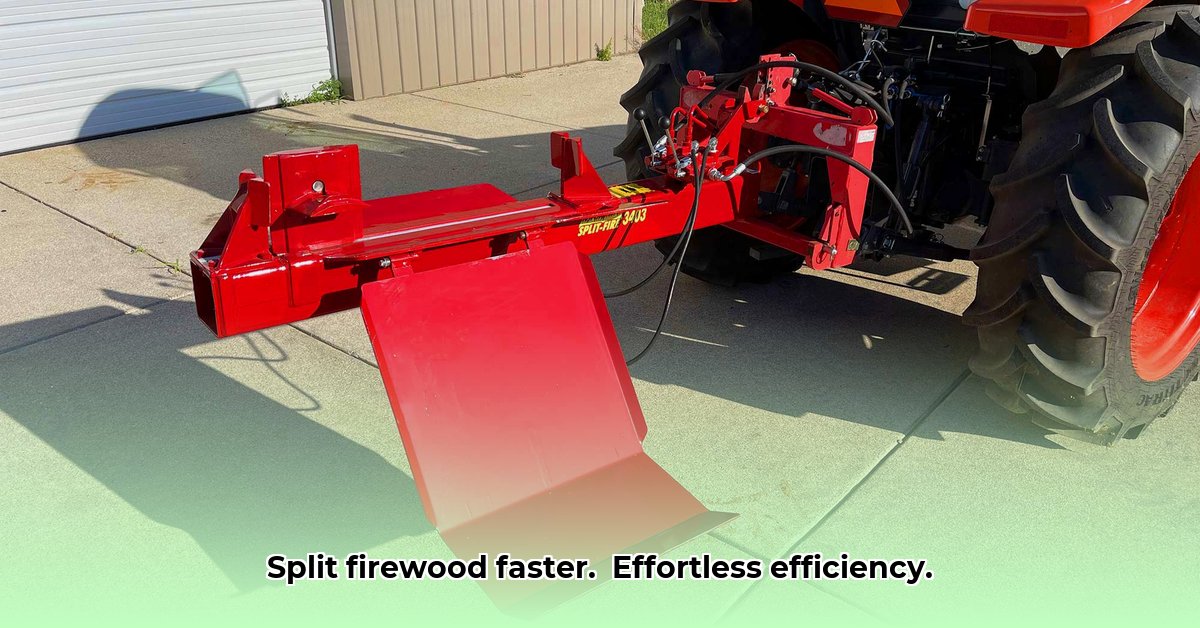
Tractor Log Splitters: A Powerful Tool for Firewood Production
Splitting firewood by hand is arduous and time-consuming. Tractor log splitters offer a significant advantage, dramatically increasing firewood production efficiency. These machines leverage a tractor's power to effortlessly process large volumes of logs, significantly reducing labor and increasing output. However, while the efficiency gains are undeniable, a balanced assessment requires considering the environmental impact. For compact tractor options, check out these compact tractor attachments.
How Tractor Log Splitters Work: Hydraulic Power for Efficient Splitting
Tractor log splitters utilize the tractor's power take-off (PTO) to drive a hydraulic pump. This pump generates substantial pressure, powering a splitting ram that quickly and efficiently splits logs. The splitting force and speed vary across models, influencing the overall efficiency. Choosing a model appropriate for your needs and the volume of wood you plan to split is crucial.
Beyond Speed: Environmental Considerations in Firewood Production
The increased efficiency of tractor log splitters presents a trade-off: while they significantly reduce manual labor, they consume fuel. The environmental impact involves not only fuel consumption during operation but also the manufacturing and transportation of the machines themselves. Understanding the complete environmental picture requires consideration of the entire life cycle of the splitter, from its manufacturing to its eventual disposal. Further research is needed to quantify this impact precisely. Dr. Emily Carter, Professor of Chemical and Biological Engineering at Princeton University, notes, "A comprehensive life cycle assessment (LCA) is necessary to fully understand the environmental impact, considering factors like fuel consumption, manufacturing processes, and end-of-life disposal."
Minimizing the Environmental Footprint of Tractor Log Splitters
Sustainable practices are vital to mitigate the environmental impact of using tractor log splitters. Prioritizing sustainably harvested wood is paramount. Efficient operation techniques such as minimizing idle time and coordinating wood splitting with other farm tasks help to reduce fuel consumption. Selecting splitters with fuel-efficient engines and low-emission technologies further diminishes the carbon footprint.
Key Considerations for Sustainable Use:
- Sustainable Wood Sourcing: Ensure the wood originates from responsibly managed forests.
- Fuel Efficiency: Optimize tractor usage and choose fuel-efficient splitter models.
- Maintenance: Regular maintenance maximizes efficiency and extends the machine's lifespan.
- Proper Disposal: Responsible disposal of the splitter and its components at the end of its life.
Choosing the Right Tractor Log Splitter: Factors to Consider
Selecting the appropriate tractor log splitter depends on several factors. The annual firewood volume, budget, and frequency of use significantly influence the choice. While larger, more powerful models are suitable for large-scale operations, smaller models may suffice for occasional use. Ensure your tractor possesses sufficient horsepower to operate it effectively, avoiding both over- and underpowering.
Step-by-Step Guide to Efficient Log Splitting
- Thorough Research: Compare various models, studying their features, power output, and cost. Read reviews and compare specifications.
- Assess Needs: Determine your annual firewood requirements to choose a splitter with the appropriate capacity. Consider log size and type.
- Prioritize Sustainability: Use sustainably sourced wood and practice fuel-efficient operation.
- Regular Maintenance: Ensure regular maintenance for optimal performance and longevity.
Balancing Efficiency and Environmental Responsibility
Tractor log splitters offer substantial improvements in firewood production efficiency, reducing manual labor. However, responsible use and conscious consideration of their environmental impact are vital. By adopting sustainable practices, making informed decisions, choosing appropriate models, and prioritizing responsible wood sourcing, we can maximize the efficiency gains while minimizing environmental consequences. Ongoing research will likely further refine the technology, reducing the environmental footprint of these machines.
How to Reduce Environmental Impact of Tractor Log Splitters in Sustainable Forestry
Key Takeaways:
- Tractor log splitters significantly boost efficiency but require careful management of their environmental footprint.
- Sustainable forestry practices and responsible wood sourcing are essential.
- Minimizing fuel consumption is key to reducing environmental impact.
- Proper maintenance and responsible material disposal are vital.